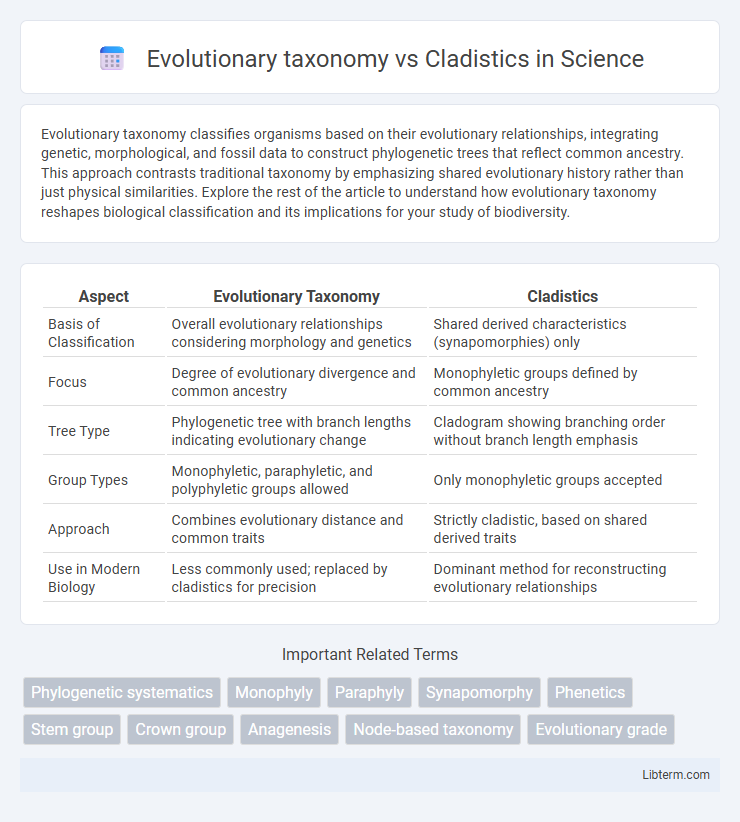Evolutionary taxonomy classifies organisms based on their evolutionary relationships, integrating genetic, morphological, and fossil data to construct phylogenetic trees that reflect common ancestry. This approach contrasts traditional taxonomy by emphasizing shared evolutionary history rather than just physical similarities. Explore the rest of the article to understand how evolutionary taxonomy reshapes biological classification and its implications for your study of biodiversity.
Table of Comparison
| Aspect | Evolutionary Taxonomy | Cladistics |
|---|---|---|
| Basis of Classification | Overall evolutionary relationships considering morphology and genetics | Shared derived characteristics (synapomorphies) only |
| Focus | Degree of evolutionary divergence and common ancestry | Monophyletic groups defined by common ancestry |
| Tree Type | Phylogenetic tree with branch lengths indicating evolutionary change | Cladogram showing branching order without branch length emphasis |
| Group Types | Monophyletic, paraphyletic, and polyphyletic groups allowed | Only monophyletic groups accepted |
| Approach | Combines evolutionary distance and common traits | Strictly cladistic, based on shared derived traits |
| Use in Modern Biology | Less commonly used; replaced by cladistics for precision | Dominant method for reconstructing evolutionary relationships |
Introduction to Evolutionary Taxonomy and Cladistics
Evolutionary taxonomy classifies organisms based on shared ancestry and morphological similarities, integrating both evolutionary relationships and overall similarity in traits. Cladistics organizes species strictly by common descent using shared derived characteristics (synapomorphies) to construct branching phylogenetic trees called cladograms. While evolutionary taxonomy emphasizes overall resemblance and genetic distance, cladistics prioritizes monophyletic groups to reflect exact evolutionary pathways.
Historical Perspectives on Biological Classification
Evolutionary taxonomy, rooted in the 19th-century work of Charles Darwin and Ernst Haeckel, organizes organisms by both common ancestry and overall similarity, incorporating evolutionary relationships alongside morphological traits. Cladistics, developed by Willi Hennig in the mid-20th century, revolutionized biological classification by strictly grouping organisms based on shared derived characteristics (synapomorphies) to reflect precise phylogenetic relationships. The historical shift from evolutionary taxonomy to cladistics marked a crucial transition towards more objective and reproducible methods for depicting evolutionary history in systematics.
Core Principles of Evolutionary Taxonomy
Evolutionary taxonomy combines phylogenetic relationships with overall similarity and evolutionary significance, emphasizing the degree of morphological divergence alongside genetic lineage. Core principles include the recognition of paraphyletic groups based on shared ancestral traits and the importance of adaptive evolutionary changes in classification. This approach balances traditional taxonomy's focus on phenotypic traits with evolutionary history to reflect both lineage branching and functional divergence.
Essential Concepts in Cladistics
Cladistics emphasizes the classification of organisms based strictly on common ancestry and shared derived characteristics (synapomorphies), forming monophyletic groups called clades. This method uses phylogenetic trees to represent evolutionary relationships, highlighting branching events without considering overall similarity or evolutionary grade, which contrasts with evolutionary taxonomy's incorporation of both ancestry and morphological similarity. Essential concepts in cladistics include the identification of homologous traits, the principle of parsimony to minimize evolutionary steps, and the exclusive focus on monophyletic groups for robust classification.
Methodological Differences: Evolutionary Taxonomy vs Cladistics
Evolutionary taxonomy integrates morphological characteristics with evolutionary relationships, using both phenotypic similarities and genetic data to group organisms, often incorporating ancestral lineage and degree of divergence. Cladistics strictly relies on shared derived characteristics (synapomorphies) to construct phylogenetic trees, emphasizing monophyletic groups and avoiding considerations of overall similarity or evolutionary distance. The methodological difference lies in evolutionary taxonomy's blend of multiple data types for classification versus cladistics' exclusive focus on lineage and common ancestry for defining clades.
Strengths and Limitations of Evolutionary Taxonomy
Evolutionary taxonomy strengths include incorporating both morphological traits and evolutionary history, allowing for a nuanced classification that reflects ancestral relationships and degrees of divergence. Its limitation lies in subjective weighting of traits, potentially leading to inconsistent groupings and less precise phylogenetic accuracy compared to cladistics. This approach may also struggle with convergent evolution, where similar traits evolve independently, complicating true lineage determination.
Advantages and Challenges of Cladistics
Cladistics provides a more objective and testable framework for classifying organisms based on shared derived characteristics (synapomorphies), enhancing accuracy in depicting evolutionary relationships. Its advantage lies in producing monophyletic groups that reflect common ancestry, which improves the understanding of phylogenetic branching patterns. Challenges include difficulty in character selection due to convergent evolution and incomplete fossil records, which can complicate the reconstruction of accurate cladograms.
Case Studies: Practical Applications in Modern Taxonomy
Evolutionary taxonomy incorporates both genetic relationships and morphological traits, allowing case studies like the classification of reptiles and birds to highlight transitional forms and evolutionary history. Cladistics relies strictly on shared derived characteristics, seen in practical applications such as the phylogenetic analysis of mammals, which refines understanding of lineage divergence using molecular data. Modern taxonomy benefits from integrating case studies that demonstrate how evolutionary taxonomy provides context for adaptive traits, while cladistics offers precise evolutionary relationships for robust classification systems.
Debates and Controversies in Systematics
Evolutionary taxonomy and cladistics represent two contrasting approaches in systematics, where evolutionary taxonomy incorporates both phenotypic similarity and evolutionary relationships, while cladistics strictly emphasizes shared derived characteristics to construct monophyletic groups. Debates arise over evolutionary taxonomy's subjective weighting of traits versus cladistics' objective criteria, leading to controversies about paraphyletic groups and the definition of taxa. The clash influences classification stability, with some systematists arguing cladistics provides greater phylogenetic accuracy, while others defend evolutionary taxonomy for its practical alignment with organismal diversity and evolutionary processes.
Future Directions in Biological Classification
Future directions in biological classification emphasize integrating genomic data with traditional evolutionary taxonomy to enhance accuracy in depicting phylogenetic relationships. Advances in computational methods are promoting the use of cladistics frameworks combined with evolutionary taxonomy, enabling more robust and dynamic classification systems. These integrative approaches aim to resolve ambiguities in species delineation and improve predictive models of evolutionary traits and biodiversity patterns.
Evolutionary taxonomy Infographic

 libterm.com
libterm.com